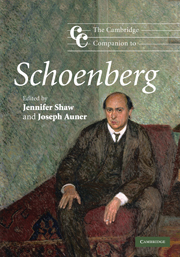Book contents
- Frontmatter
- 1 Introduction
- Part I Schoenberg's early years
- 2 Schoenberg's lieder
- 3 Schoenberg and the tradition of chamber music for strings
- 4 Two early Schoenberg songs: monotonality, multitonality, and schwebende Tonalität
- 5 Arnold Schoenberg and Richard Strauss
- Part II Schoenberg, modernism, and modernity
- Part III Schoenberg between the World Wars
- Part IV Schoenberg's American years
- Notes
- Select bibliography
- Index
5 - Arnold Schoenberg and Richard Strauss
from Part I - Schoenberg's early years
Published online by Cambridge University Press: 28 September 2011
- Frontmatter
- 1 Introduction
- Part I Schoenberg's early years
- 2 Schoenberg's lieder
- 3 Schoenberg and the tradition of chamber music for strings
- 4 Two early Schoenberg songs: monotonality, multitonality, and schwebende Tonalität
- 5 Arnold Schoenberg and Richard Strauss
- Part II Schoenberg, modernism, and modernity
- Part III Schoenberg between the World Wars
- Part IV Schoenberg's American years
- Notes
- Select bibliography
- Index
Summary
The pairing of the names of Richard Strauss (1864–1949) with Arnold Schoenberg is not one that comes readily to mind, certainly not for Schoenberg scholars in any event. Critical commentaries on their music rarely find much common ground when comparing the musical styles of these two diverse composers. Strauss's place in music history is often seen as one of the last viable vestiges of the so-called New German School, taking up the Lisztian-Wagnerian notion of Musik als Ausdruck (music as expression), where the poetic idea was the basis for the structure of a work, rather than basing this structure on pre-existing or otherwise inherited musical forms. In the first decade of the twentieth century, Strauss was considered at the very forefront of musical innovation, utilizing some of the most advanced compositional techniques of the day. His work is identified by brilliant orchestration, daring harmonic treatment, and expansive musical expression. Indeed at the very moment when it looked as if the degree of chromatic extension and tonal uncertainty would propel Strauss's music into the very next stage of atonal musical expression, he ultimately stopped short of a total break from tonality. While both the operas Salome (1905) and Elektra (1908) signaled a headlong rush from extreme chromatic instability into atonality, Der Rosenkavalier (1910) was much more conventional, not only in its formal operatic conception but in its tonal clarity, set against a libretto which recounts a bittersweet love story rather than a deeply intense psychological drama.
- Type
- Chapter
- Information
- The Cambridge Companion to Schoenberg , pp. 68 - 78Publisher: Cambridge University PressPrint publication year: 2010



